‘Mary Poppins’ Still Practically Perfect
- Share via
Kids can be unnerved by the most unlikely things. When I was growing up in the late ‘50s, Howdy Doody spooked me (that huge head with its insane grin and that gangly, jangly body were too much), and the Seven Dwarfs put my sister under her movie seat, wailing.
It seems as if everybody has a story about a supposedly innocent childhood character. A good friend of mine once confessed that lovable, dear Mary Poppins rattled her. The notion of a baby-sitter who could fly by opening an umbrella was a little weird for her 6-year-old sensibilities. Her mother had to assure her that no such woman was invited to their house.
Of course, my friend must have been in the small minority. “Mary Poppins” (screening Friday night in Brea’s Arovista Park Amphitheater) was a box-office heavyweight for Disney. Parents and their broods went in with great expectations (the studio had its publicity machine in customary overdrive), and many came out humming an odd ditty with a 34-letter title that you can’t forget nowadays even if you wanted to.
“Supercalifragilisticexpialidocious” was one of the songs in Richard M. Sherman and Robert B. Sherman’s score that went on to win the Academy Award in 1964, and “Mary Poppins,” my friend’s criticism notwithstanding, picked up four other Oscars, including best actress for Julie Andrews in the title role.
Two of the awards were for visual effects (by Peter Elenshaw) and editing (Cotton Warburton), mostly in response to the scenes in which animation was gracefully joined with live acting. Andrews and co-star Dick Van Dyke connect with a menagerie of cartoon creatures as if they were on the same level; the Robert Stevenson-directed film was the “Roger Rabbit” of its day, real cutting edge.
The story, however, was typical for Disney, both fanciful and fantastic. The prim Mary is brought in to watch over the Banks children in old London. She’s a Victorian nanny with a difference, though. Magic is her comrade, and through it, she spirits the kids into minor adventures, all the while underlining the firmest of family values.
Andrews, in her first movie role, brings her usual wholesomeness and a major-league singing voice to the party. She has an amusing counterpoint in Van Dyke, who plays the rubber-limbed, Cockney-voweled street entertainer, Bert. Glynis Johns is the forever distracted suffragette, Mrs. Banks, and David Tomlinson brings a harmless scowl to Mr. Banks, a worried banker.
Van Dyke and Andrews, especially, move casually through “Mary Poppins,” which is as lightweight as Mary’s bumbershoot. As usual with “family” pictures, there are several messages aimed at kids. Mary, first and foremost, is interested in tidiness, but she also believes in sentiment and the merits of a keen imagination.
Kids are told to conform to the rules but also express themselves; it’s a point Disney has often made, one most parents have found comforting over the years. “Mary Poppins” has proven to be one of Disney’s more durable little comforts. Besides, there’s no trace of Howdy Doody anywhere.
More to Read
Only good movies
Get the Indie Focus newsletter, Mark Olsen's weekly guide to the world of cinema.
You may occasionally receive promotional content from the Los Angeles Times.










